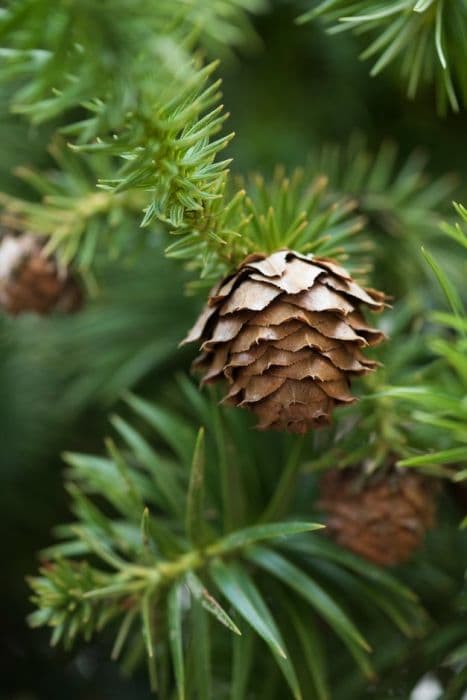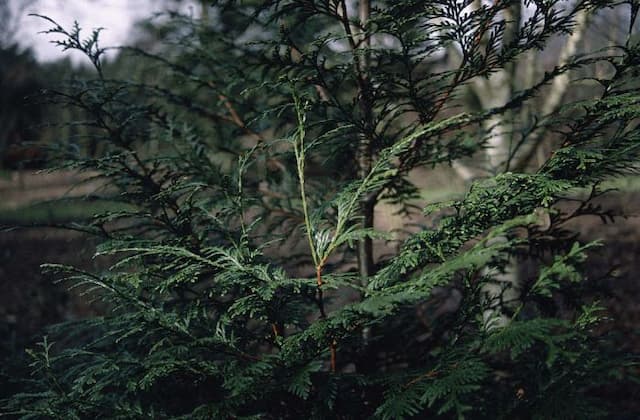Hiba Arborvitae Thujopsis dolabrata

ABOUT
The plant commonly known as Hiba Arborvitae is an evergreen conifer with a distinctive appearance. Leaves on this plant are scale-like, closely overlapped and arranged in a flattened, fan-like spray that displays a glossy green hue on the upper side with a noticeable white stomatal band on the underside, giving a two-toned effect. The foliage exudes a pleasant fragrance when crushed. The bark is fibrous and reddish-brown, providing a rugged texture that contrasts nicely with the smoothness of the leaves. Cones are another characteristic feature; they are small, oval to round, and brownish when mature, usually bearing several thin, broad scales that give them a somewhat distinctive appearance compared to other conifer cones. Branches of this plant are dense, creating a lush, thick foliage canopy that fans outwards, giving it a full, robust look that adds to its ornamental value. This plant remains green throughout the year, offering a constant display of vibrant greenery in the landscapes where it is grown.
About this plant
 Names
NamesSynonyms
Hiba Arborvitae, Hiba, False Arborvitae, Deerhorn Cedar
Common names
Thujopsis dolabrata var. hondai, Thuja dolabrata, Thujopsis dolabrata f. hondae, Thujopsis dolabrata var. hondae.
 Toxicity
ToxicityTo humans
Hiba is not generally recognized as a toxic plant to humans. There is limited information on its toxicity, and while it is not typically ingested due to its nature as an ornamental tree, there are no well-documented symptoms of poisoning in humans from consuming any part of the Hiba plant. However, as with many plants, sensitive individuals may experience allergic reactions or skin irritation from handling it, and caution is advised.
To pets
Hiba is also not commonly known to be toxic to pets. Similar to its effects on humans, there's a lack of substantial evidence pointing to any significant toxic effects on pets from ingesting this plant. However, the essential oils contained in the plant could potentially cause mild gastrointestinal upset if ingested in large quantities. Always monitor your pets around ornamental plants and contact a veterinarian if you suspect they have ingested plant material and are showing signs of distress.
 Characteristics
CharacteristicsLife cycle
Perennials
Foliage type
Evergreen
Color of leaves
Green
Height
35 feet (10.67 meters)
Spread
15 feet (4.57 meters)
Plant type
Tree
Hardiness zones
5
Native area
Japan
Benefits
 General Benefits
General Benefits- Landscape Aesthetics: Thujopsis dolabrata, commonly known as Hiba Arborvitae, adds visual interest to landscapes with its unique, striking foliage and pyramidal shape.
- Privacy Screen: It can be used to create a dense hedge or screen for privacy due to its thick foliage.
- Windbreak: The sturdy nature of Hiba Arborvitae makes it a good choice for a windbreak, offering protection for smaller plants and reducing wind speed in gardens.
- Noise Reduction: Its dense growth habit helps absorb sound, making it useful for reducing noise pollution in urban gardens or near roads.
- Habitat for Wildlife: The tree provides shelter and nesting sites for birds and other wildlife.
- Durability: Hiba Arborvitae is known to be a long-lived and resilient tree, requiring minimal maintenance once established.
- Ornamental Cones: The small, decorative cones add visual appeal and can be an added feature in the garden during different seasons.
- Shade: With its broad canopy, it offers shade in parks and gardens, making it a practical addition for sunny areas.
- Cultural Significance: In Japan, the wood of Hiba Arborvitae is valued for its use in construction and crafts due to its durability and pleasant scent.
- Soil Stabilization: The root system helps prevent soil erosion, making it useful for planting on slopes or in areas prone to losing topsoil.
 Medical Properties
Medical Properties- Antibacterial: Thujopsis dolabrata extract has shown antibacterial activity against various bacteria such as Staphylococcus aureus.
- Antifungal: The essential oils of Thujopsis dolabrata may have antifungal properties effective against certain fungal species like Candida.
- Insecticidal: The plant's compounds have been researched for their potential to act as natural insect repellants or insecticides.
- Anti-inflammatory: Some compounds in Thujopsis dolabrata have been studied for their possible anti-inflammatory effects when applied topically.
- Antioxidant: There is potential for antioxidants in Thujopsis dolabrata's extracts, which could help in preventing oxidative stress-related damages in cells.
 Air-purifying Qualities
Air-purifying QualitiesThis plant is not specifically known for air purifying qualities.
 Other Uses
Other Uses- Woodcraft: Hiba wood is highly valued for its durability and fine grain, making it an excellent material for creating high-quality furniture and intricate carvings.
- Construction Material: In Japan, Thujopsis dolabrata is traditionally used in construction, especially for building wooden homes and temples due to its resistance to rot.
- Ornamental Plant: Hiba is often grown as an ornamental tree in gardens and parks for its attractive foliage and pyramidal shape.
- Bonsai: The tree can be trained as a bonsai, a Japanese art form where trees are grown in containers and meticulously shaped for aesthetic contemplation.
- Soundproofing: Due to its dense wood, Hiba is sometimes used in soundproofing applications for walls or floors in buildings.
- Forestry: The Hiba tree plays a role in forestation projects as it is fast-growing and helps to stabilize soil, preventing erosion.
- Aromatic Uses: The wood and leaves of Hiba emit a pleasant scent, and wood shavings are used in sachets or closets to impart their fragrance and deter insects.
- Culinary Smoking: Wood chips from the Hiba tree are used for smoking foods to imbue a distinctive flavor that is subtle and aromatic.
- Traditional Crafts: The Ainu people of Japan utilize Hiba wood in their traditional craftwork, recognizing its spiritual significance and practical qualities.
- Cultural Symbolism: Hiba is sometimes planted in memorial gardens or spaces with cultural significance as a symbol of longevity and resilience.
Interesting Facts
 Feng Shui
Feng ShuiThujopsis dolabrata, commonly known as Hiba Arborvitae, is not used in Feng Shui practice.
 Zodiac Sign Compitability
Zodiac Sign CompitabilityHiba Arborvitae is not used in astrology practice.
 Plant Symbolism
Plant Symbolism- Longevity: Thujopsis dolabrata, commonly known as hiba, is a species of evergreen tree which is often associated with long life due to its natural durability and resistance to decay.
- Resilience: The hiba is known for its ability to withstand harsh conditions, symbolizing resilience and strength in the face of adversity.
- Protection: Hiba wood is believed to emit a pleasant aroma that is said to repel insects, which gives it a cultural association with protection and purification.
 Water
WaterThe Hiba arborvitae should be watered deeply once or twice a week rather than shallow, frequent waterings. During the growing season, ensure the soil remains evenly moist but not waterlogged, providing about 1 to 1.5 gallons of water each time you water. Adjust the amount of water and frequency based on weather conditions: reduce watering during rainy periods and increase during droughts. In winter, watering can be cut back since the plant's growth slows down and its water needs decrease.
 Light
LightHiba arborvitae prefers full sun to partial shade. It thrives best in a location where it receives at least six hours of direct sunlight daily, but it can also tolerate some shade. Avoid placing it in deep shade as this will inhibit growth and may lead to poor plant health.
 Temperature
TemperatureHiba arborvitae is hardy and can endure a temperature range typically between -20 to 70 degrees Fahrenheit. This plant prefers cooler climates and may struggle in areas where temperatures frequently exceed 80 degrees Fahrenheit. Ideally, maintain an environment where temperatures stay within 40 to 60 degrees Fahrenheit for optimal growth.
 Pruning
PruningPrune the Hiba arborvitae to maintain its shape and size, as well as to remove any dead or damaged branches. The best time to prune is in the late winter or early spring before the new growth starts. Prune sparingly, as Hiba arborvitae does not respond well to heavy cutting back. Typically, it needs pruning once a year or even less frequently if growing in ideal conditions.
 Cleaning
CleaningAs needed
 Soil
SoilHiba arborvitae thrives in moist, well-drained soil with a pH range of 5.5 to 6.5. A mixture of loamy soil, peat, and pine bark is recommended to provide the necessary drainage and acidity.
 Repotting
RepottingHiba arborvitae should be repotted every two to three years to refresh the soil and encourage healthy growth. However, mature plants may be repotted less frequently.
 Humidity & Misting
Humidity & MistingHiba arborvitae prefers a moderate humidity level, similar to its native habitat in forests. Consistent humidity levels mimic its ideal growing conditions.
 Suitable locations
Suitable locationsIndoor
Provide bright light, maintain moderate humidity, and avoid hot, dry air.
Outdoor
Plant in partial shade, shelter from strong winds, and mulch the base.
Hardiness zone
5-7 USDA
 Life cycle
Life cycleThujopsis dolabrata, commonly known as hiba arborvitae or hiba, begins its life as a seed, typically produced after pollination between male and female cones on mature specimens. Once a seed finds suitable soil and environmental conditions, it germinates, giving rise to a small seedling with a main root that anchors into the soil and allows for uptake of water and nutrients. As the seedling matures, it grows into a sapling, gradually developing a woody stem and a characteristic conical shape, with branching patterns that start to form the structure of the mature tree. During its growth, hiba arborvitae develops scale-like leaves and, upon reaching sexual maturity, it produces cones; male cones release pollen while female cones receive pollen for fertilization. Once fertilized, the female cones develop seeds, which when mature, are released into the environment to perpetuate the species. The hiba arborvitae can live for hundreds of years, during which it can reach significant heights and contribute to forest ecosystems before ultimately senescing and decomposing, returning nutrients to the soil.
 Propogation
PropogationPropogation time
Spring-Early Summer
The Hiba arborvitae, also known as Thujopsis dolabrata, is most commonly propagated through semi-hardwood cuttings. This method involves taking cuttings from the current year’s growth in late summer or early fall when the wood has partially matured but is not fully hardened. Cuttings about 4 to 6 inches (10 to 15 centimeters) long are snipped just below a node, and the lower leaves are removed. The cut end can be treated with a rooting hormone to encourage root development and then planted in a well-draining potting mix. The pot should be kept in a warm, humid environment out of direct sunlight, and the soil should be kept consistently moist but not waterlogged until the cuttings have rooted, which may take several weeks. Maintaining high humidity can be achieved by covering the pot with a plastic bag or using a propagation dome to prevent the cuttings from drying out.









